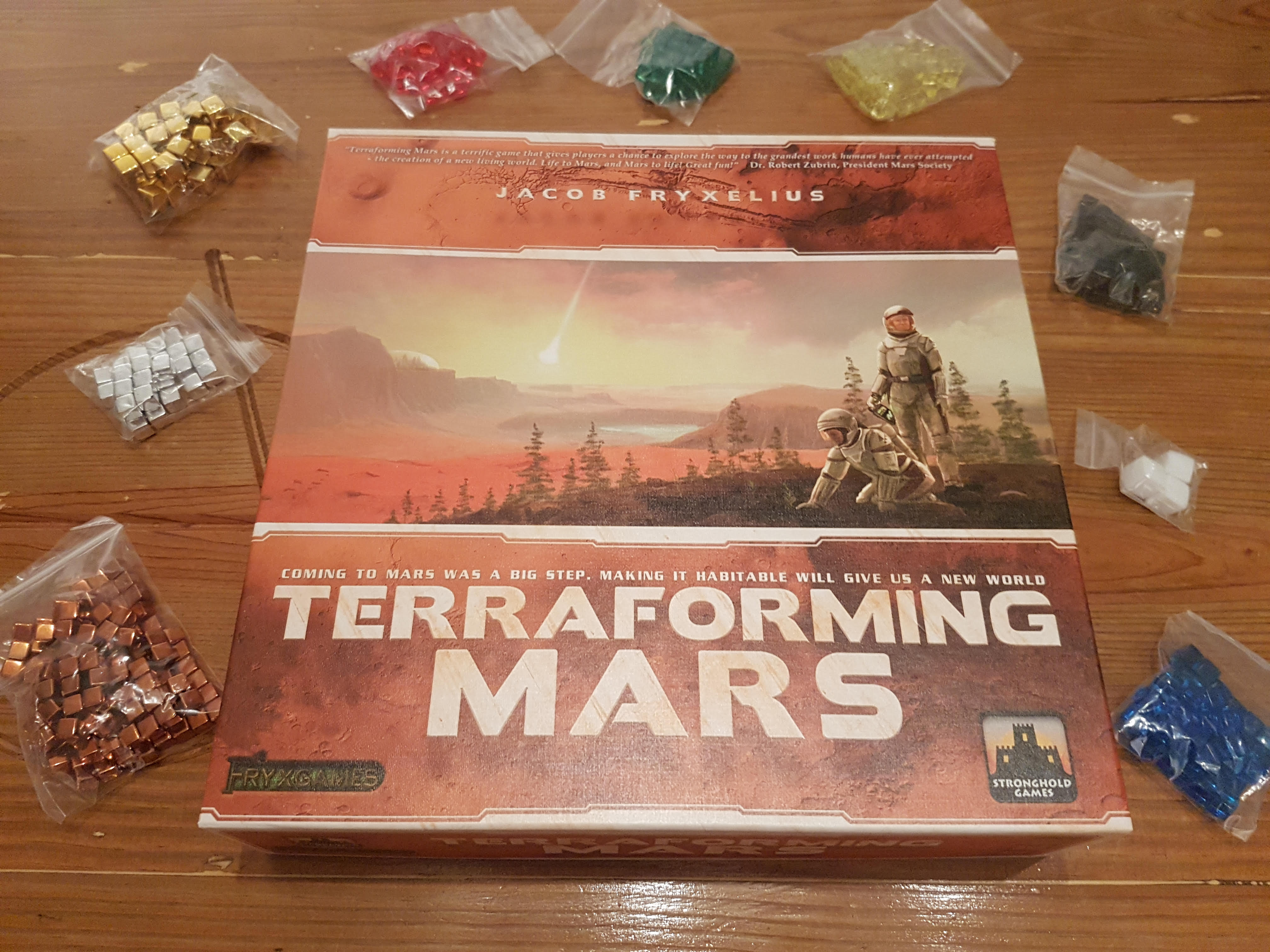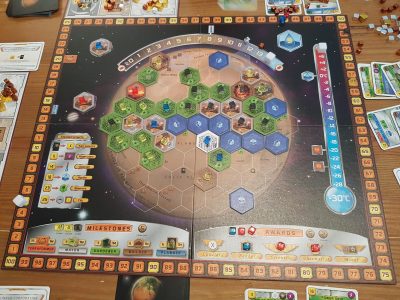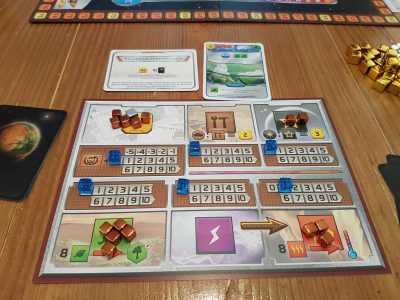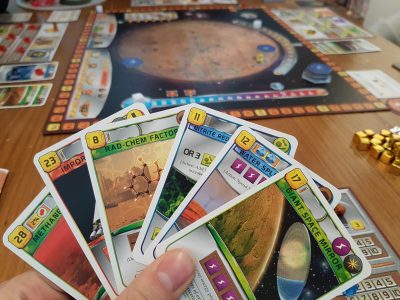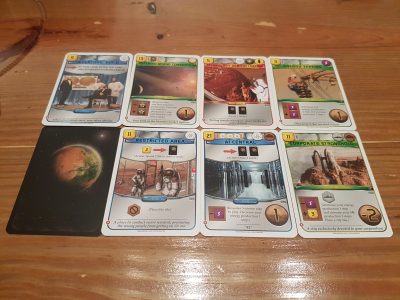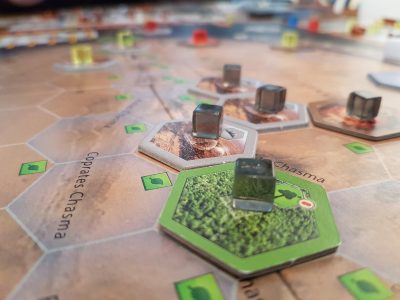Terraforming Mars is a science fiction themed engine building, tile placement and card based board game from designer Jacob Fryxelius and publisher FryxGames. The game sees 1 – 5 players take control of giant corporations, in the 2400s. Unsurprisingly from the title, these corporations are looking to be the best at terraforming the planet of Mars. With options for card drafting and variable player powers the game can grow alongside player experience, though is this game outside of the goldilocks zone of great games? Let’s find out!
To make sense of the game it is best to start with what ends it. Throughout the game players will be affecting Mars in numerous ways. Some of the actions players will take will affect the planet’s oxygen levels, temperature and ocean count. When each of these three factors has reached the measurement limit (14%, 8 degrees Celsius and 9 oceans respectively) the planet is deemed to have been terraformed and the game finishes at the end of the generation, what Terraforming Mars calls a round.
So, how does any of this occur? Let’s start at the beginning, now with some context to what is going on. To setup the game each player will take an identical player board, a set of coloured player cubes and a corporation card. For beginners these corporation cards will offer each player identical starting items of 10 cards and 42 MegaCredits (M€). Each player will start with a basic Terraforming Rating of 20, this not only is part of your final victory point score but also is part of your corporation’s income. In advanced games, players can choose to start with unique corporations that have unique effects, different starting MegaCredit amounts, differing starting productions and potentially a fixed first action.
Once setup is complete the game begins, with each generation consisting of 4 phases. For the first generation the initial 2 phases are skipped, having effectively been wrapped into the setup. The first phase is simply passing on the first player marker to the next player. Phase two is the research phase. By default, each player receives 4 cards from the deck and can pay 3 M€ per card to keep them. For additional balance players can choose to instead deal 4 cards out to each player, then card draft four each before purchasing cards.
Phase three is the action phase, and is the longest of the phases. During this phase player will take it in turns taking 1-2 actions, until all players have passed. There are 7 actions available to players, which are: play a card, use one of the 6 Standard projects on the board, convert 8 plant resources into a greenery tile and place it onto Mars (which in turn raises the oxygen levels 1%), spend 8 heat resource cubes to raise the temperature by 2 degrees, use the action written on a played card, pay to claim a Milestone or fund an Award.
It sounds like a lot to choose from, and to be honest it is for a new player early on in the game, though for some actions you will have to build up resources to be able to do them. Cards will come with an associated MegaCredit cost, and potentially a restriction such as needing 6% oxygen. Playing a card can earn the player resources, up their production of a resource type, allow them to effect one of the three terraforming parameters (doing so increases a player’s terraforming rating), place a city or special tile onto the board and much more. Generally early game it seems best to build up a bit of a production engine to allow players to spend more later, though it isn’t always that simple.
Milestones and awards are very similar and can earn players victory points. Each has multiple options though only 3 of each can be purchased during the game. Milestones, such as Gardener for controlling 3 greenery hexagons on Mars, can be claimed whenever you fulfil its requirement for 8 MegaCredits. Once claimed no-one else can claim it and it’ll award 5 victory points to that player at the end of the game. Awards are similar though come with a slight risk. Costing 8, 14 and 20 MegaCredits, depending on if they are the 1st, 2nd or 3rd award to be funded, offer a potential points return. For example, if funded the Thermalist award grants 5 points to whomever has the most heat resource cubes at the end of the game, and 2 points to whomever is second. You could therefore fund this award and not qualify for either reward!
The final phase is production. Playing cards is a common way to earn resources but a lot will also come from production. By upgrading your production of a resource type you’ll get an income of it at the end of each generation. Steel, Titanium, Plants, and Heat all work the same way being from 0 upwards and the resources add up over time if left unspent. Energy is slightly different as during the production phase, before new energy resources are added, any leftover cubes are converted directly into heat, using a 1 to 1 conversion rate. MegaCredit production is the only resource that can become negative, down to -5, however each round you add your production and terraforming rating together to determine your income.
When the terraforming is complete the game comes to an end, Mars is no longer baron and players should have built up a fair amount of points. Points are then added up for each player, starting with their terraforming rating as their base score. On top of this 1VP is scored for each greenery tile built on Mars, 1VP for each greenery tile surrounding built cities and points earnt from cards. After all of the ways to score have been combined the winner is the corporation with the highest score.
As mentioned, there is a variant which replaces the simple drawing from the deck in the research phase with drafting. Per generation minutes will be added to the overall game length but players seemed happier with the experience once the switch had been made. For the sake of everyone gaining a sense that the game is balanced, stopping luckily top drawing the best cards, this rule should be mandatory, at least after a beginner game. For your first game you’ll be already spending plenty of additional time reading each round, and drafting only exponentially increases this process. After a game or two players will have a much better understanding of what is possible and then drafting can be brought in to increase the deck’s balance.
Terraforming Mars is a bit of a mixed bag of production quality. The elements don’t feel like they are from the same standard of game. There are great components; an awesome board, embodying the baron Martian landscape that is slowly turned green via thick cardboard hexagon tiles, and the easy to recognise player marker cubes. The cubes in glorious bronze, silver and gold look visually awesome, despite players needing a moment to become accustomed to using them for everything from money to heat.
Conversely, some of the elements are lacklustre at best, unfortunately starting with the player boards that have solid components placed on top of them. They are thin cardboard at best and are probably the component that will last the least amount of plays. Whether the choice to not include Scythe-like indented boards was the keep the price down, even a thicker more robust board would have sufficed. The box itself for Terraforming Mars isn’t exactly great either, featuring no dividers and only bags. Given the size of the box this allows the components, including those thin player boards to freely move around when transporting the game, which is not exactly great for keeping the game in pristine condition.
Then it comes to the artwork of the 200 plus unique cards. Put simply, it would be an improvement if they all featured unique custom illustrations. This being said, they are all in theme and when you’re playing you don’t pay it much attention, so they don’t detract from the gameplay. It’s only after the game is over when you look over the card based engine in front of you that you’ll start to see the discontinuity between them all. For what is already a relatively expensive board game making the game more affordable by not commissioning so much unique art has to have been the right decision if it means more can play this epic game.
The rulebook isn’t inherently bad but it does briefly mention concepts, skimming over them in the middle of a sentence, to then not explain them until later in the booklet. I found myself flicking back and forth a couple of times trying to see if I’d missed something. This can be a little problematic for learning or teaching, yet it must be said that it is entirely possible to understand how the game is to be played by reading through it carefully, just don’t skim read and you’ll be fine.
It is hard to talk about the balance of the game in detail due to its vastness. Some cards will seem almost over-powered then you’ll notice not only will you have to pay 3 M€ to keep it, reducing your available credits for the round, but it might have an extremely high cost to play. Take a card that costs around 25 M€, early game that’ll be potentially the only action you will be able to take that entire generation, so you have to trade off what it is truly worth.
After a string of losses, I have yet to find anything overpowered, though seemingly neither have my winning opponents. In a 2-player game getting your engine going first will most probably gift you the victory, while with more players you can target a player obviously doing better with some of the negative effect actions. As far as specific corporations or strategies go, I’ve tried to follow winning routes as done by others only for them to not work out for me. Multiple routes and strategies seem open to players and none seem to gift an unholy advantage. Perhaps overtime specific cards or actions may shine through as powerful but given the amount of combinations of cards I doubt anything overpowered will have surface even after countless games.
Terraforming Mars is one of those big blockbuster style games, it commands table presence, it takes a couple of hours to play, yet it exudes awesomeness. Be prepared for your first game to go easily an hour over the 2-hour mark, even in the middle range of the player count. You’ll spend a lot of time reading what the cards do before you have an understanding of what is a best, something only increased by drafting. Nevertheless, smash like an asteroid past this learning curve and there is a terrific and solidly built game underneath, ready to excite players and entertain them for many hours to come. It is a testament to how great the game is that no matter how many times I lose I want to get the game back to the table! For those that will complain about elements of the production quality it is a problem but one to overcome, for science.
[Editor’s Note: Terraforming Mars was provided to us by Asmodee UK for review purposes. The game is currently available on 365 Games for £53.99. It is also available from local UK board game stores, find your local store here]

